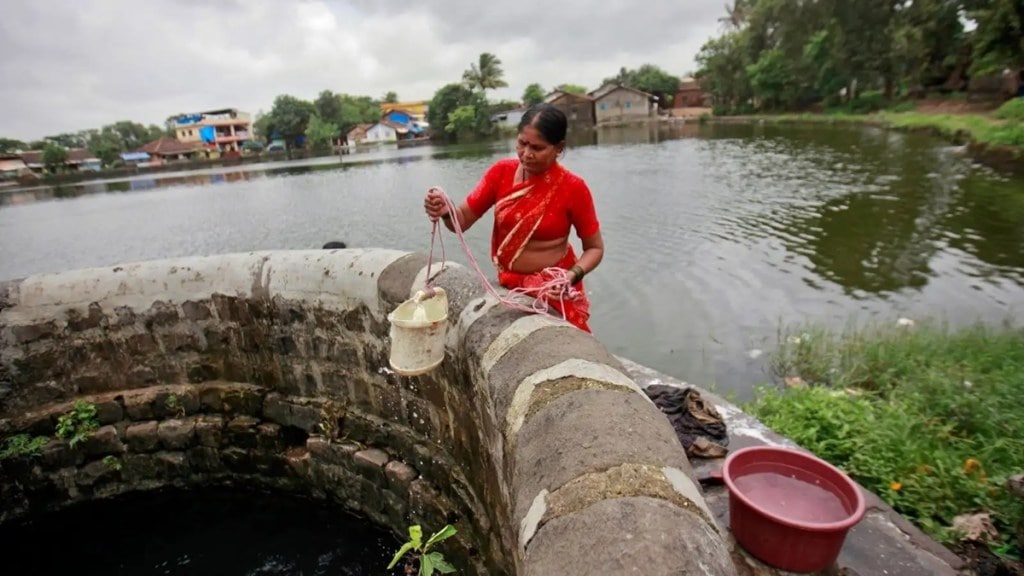By Amit Kapoor
India is an agricultural powerhouse and dominates the production of essential food grains such as rice, wheat, and pulses. This also places India at the forefront of producing water-intensive crops. In particular, paddy production in India caters to domestic demand and serves as a significant export commodity. However, the country’s agriculture sector is thriving at the cost of its finitely extractable groundwater resources that are used for irrigation.
Between 2016 and 2024, the global population increased from 7.56 billion to 8.2 billion, and India’s population increased from 1.29 billion to 1.45 billion. Meanwhile, according to the Central Groundwater Board (CGWB) Report on Groundwater Assessment, the groundwater used for irrigation increased from 38% in 2016-17 to 52% in 2023-24. The situation is expected to intensify further in the coming years.
As a result of the current farming practices and the increasing population, most districts of the top paddy-producing states such as Rajasthan (19), Punjab (19), and Haryana (14) have over-exploited their groundwater for irrigation purposes. This has numerous repercussions such as the over-exploitation of groundwater, its salinisation, and the concentration of pollutants that adversely impact the quantity and quality of extractable groundwater. Notably, most districts in Punjab, Haryana, and Rajasthan over-extract their groundwater for irrigation purposes. In addition to this, excessive use of fertilisers, especially for paddy cultivation, deteriorates the groundwater quality.
First, over-fertilisation results in increased soil salinity, which can leach into the groundwater. Rainfall is the main source of recharging groundwater and between Rajasthan, Punjab, and Haryana, Rajasthan received the highest average rainfall (608 mm) in 2023-24. Yet, its groundwater experienced the highest salinisation at 22%. This can be attributed to the fact that Rajasthan has an arid and semi-arid climate, and thus experiences a higher evaporation rate, causing higher groundwater salinity. Meanwhile, Punjab and Haryana experienced lower groundwater salinity at 2.77% and 0% respectively. This is due to their extensive canal irrigation network and adoption of micro-irrigation that avoids waterlogging and reduces their reliance on groundwater compared to Rajasthan.
Moreover, fertilisers can seep under the ground, resulting in the concentration of chemicals and metals like nitrates and uranium in the groundwater, beyond their permissible limits. For instance, nitrate contamination caused by run-off of nitrogen-based fertilisers in the groundwater is a key concern in paddy-producing states such as Maharashtra, Telangana, Andhra Pradesh, and Tamil Nadu. Similarly, phosphate fertilisers used in Rajasthan, Punjab, Haryana, Uttar Pradesh, and Tamil Nadu seep into the groundwater and cause uranium contamination. Such issues adversely impact the health of the crop and population. The groundwater becomes unfit for consumption, heightening the risk of chronic illnesses such as blue baby syndrome in infants, thyroid disorders, dental fluorosis, and cancer. Polluted groundwater also leads to lower soil health and crop yield, further reducing agricultural productivity and income. The CGWB thus cautions that if the current farming and irrigation practices continue, more than half of the districts of Punjab will potentially have no groundwater available for future use. The same scenario could be experienced in 21-23% of the districts in Haryana and Rajasthan.
Considering the prevailing issues concerning sustainable groundwater management for irrigation, India must urgently take steps to secure its agricultural future. Projections of the world population touching 8.95 billion by 2036, out of which India’s population is expected to hit 1.52 billion, underline the need to improve India’s irrigation and farming practices. This is necessary to ensure water security and agricultural sustainability in the country. The government of India has already taken a few steps in the right direction. It introduced the National Mission for Sustainable Agriculture in 2014 to promote sustainable agricultural practices like zero tillage, cover cropping, and micro-irrigation for prudent management of water resources, chemical usage, and improvement in soil health. It also announced the Pradhan Mantri Krishi Sinchai Yojana in 2015 to promote drip and sprinkler irrigation for reaping “more crop per drop”. Likewise, the Atal Bhujal Yojana announced in 2019 encourages efficient irrigation methods for judicious groundwater management specifically in Gujarat, Haryana, Karnataka, Madhya Pradesh, Maharashtra, Rajasthan, and Uttar Pradesh. According to the CGWB, 23% of the districts in the country had unsustainable groundwater levels in 2016-17, which reduced to 19% in 2023-24. This improvement can be attributed to the effectiveness of ongoing central government initiatives.
Furthermore, as agriculture is a state subject, the state governments should ramp up their efforts to address groundwater mismanagement in agriculture in a time-bound manner. Governments of states that have unsustainable groundwater levels should proactively take measures to remedy the situation. Moreover, states such as Chhattisgarh, Bihar, Jharkhand, Telangana, and Odisha that have safe groundwater levels could be encouraged to practise resource-efficient agriculture for water-guzzling crops. Some states have already taken cognisance of this. For instance, Odisha’s Integrated Irrigation Project for Climate Resilient Agriculture emphasises irrigation efficiency and climate-smart agricultural practices in the state that has already extracted about 48% of its groundwater. The project is funded through World Bank assistance at a 70:30 (Centre:state) cost-sharing basis. Such initiatives can serve as a blueprint for sustainable water management in agriculture, offering the dual benefit of preserving India’s critical groundwater reserves while ensuring long-term agricultural resilience. By scaling up these efforts, especially across the water-stressed districts, states can safeguard their water resources, enhance agricultural productivity, and bolster their contribution to global food security in an era of mounting climate challenges.
With inputs from Ananya Khurana, senior researcher, Institute for Competitiveness.
The writer is chair, Institute for Competitiveness.
Disclaimer: Views expressed are personal and do not reflect the official position or policy of FinancialExpress.com. Reproducing this content without permission is prohibited.

